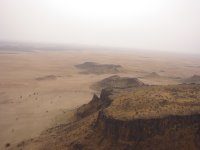My dreams are filled with sand and rocks. The sand is everywhere. It is inescapable. You find it between your toes in the evening and dust storms carry it to your breakfast table. In this environment of arid heat, human beings, animals and other living things have somehow found a way to survive. I am just beginning to fathom the conditions of the Darfurians who have been displaced, and the struggles they face on so many fronts.
On Thursday morning, we traveled by military helicopter from Nyala back to El Fasher. Surprisingly, the helicopter and its pilot were Russian, and at the beginning of the flight he stood in the front of the cockpit and explained in a soft accent that the flight would last one hour and that we would be flying at 2,000 meters. The take-off was less tumultuous than I expected, although the vehicle and its passengers trembled uncomfortably throughout the flight.
As Peter and I were seated at the very back, we could pop open the one window in the helicopter that was not sealed shut. From this vantage, one could see hundreds of kilometers of expansive desert, winding river beds with no water, and a few unexpected rock structures that appeared as if they might have come from the American west. From 2,000 meters, I could see livestock, a lone truck making its way in the sand, brick factories and a few villages. I also saw a settlement that had been burned out as well as what might have been a rebel camp. It was an odd assortment of images, thrilling in their proximity and contrast.
 The helicopter landed in El Fasher without incident and we stopped for a cool drink at a roadside shop just outside the airport and opposite the AIMIS headquarters. A gregarious officer came to the shop while we were drinking our sodas and confirmed that El Bashir, the president of Sudan, had sent a letter to Addis Ababa (where the African Union is headquartered) confirming his support for a UN-AU hybrid force.
The helicopter landed in El Fasher without incident and we stopped for a cool drink at a roadside shop just outside the airport and opposite the AIMIS headquarters. A gregarious officer came to the shop while we were drinking our sodas and confirmed that El Bashir, the president of Sudan, had sent a letter to Addis Ababa (where the African Union is headquartered) confirming his support for a UN-AU hybrid force.
The hybrid force is the “third phase” of a UN series of proposals to support the implementation of the Darfur Peace Agreement, in part through an effective peacekeeping force. The Sudanese government has not allowed the UN to have peacekeepers in the country in the past (only support personnel to the AU forces). As AMIS troops tend to be unpopular among civilians, many feel that unless UN peacekeepers arrive, the entire situation will continue to degenerate.
Most colleagues here have a working assumption that this force will come. The word on the ground is that the new AMIS Force Commander who is due to arrive in one week is the perfect person to guide a hybrid force, with both a UN and AU background. The Darfur Peace Agreement may also be modified in order to enable more signatories. For sure unless the UN forces comes with a stronger mandate for protection – that is, that they can use force if necessary to intervene – they will ultimately be a disappointment to civilians and unable to stop any spiraling violence.
Before I left Nyala I had dinner with a local human rights colleague who said that there are three armed groups in El Fasher alone, not counting the various police and security forces. As with my first visit to El Fasher, I note the strong military and police presence. Earlier today I took off an hour to take outdoor pictures – strictly forbidden – and I was able to negotiate this only because the driver was adept at knowing which areas were occupied or closely patrolled.
I have three more days of interviews here in Fasher before returning to Khartoum.
